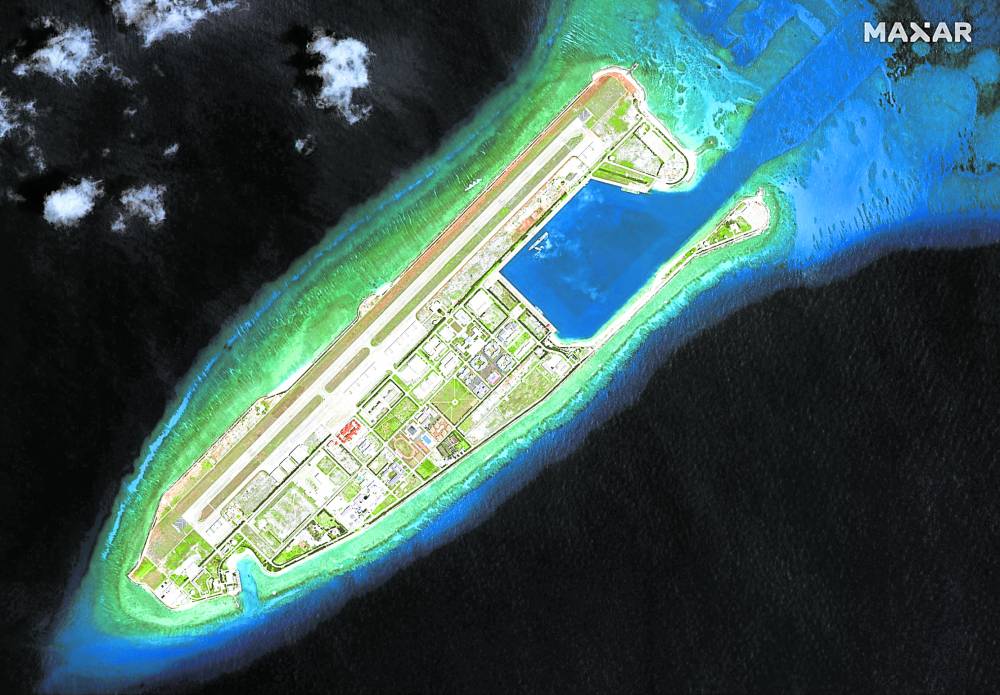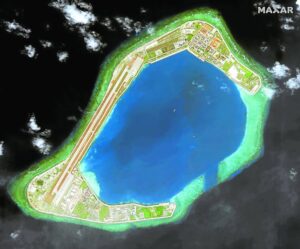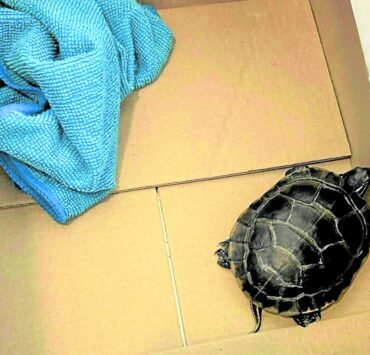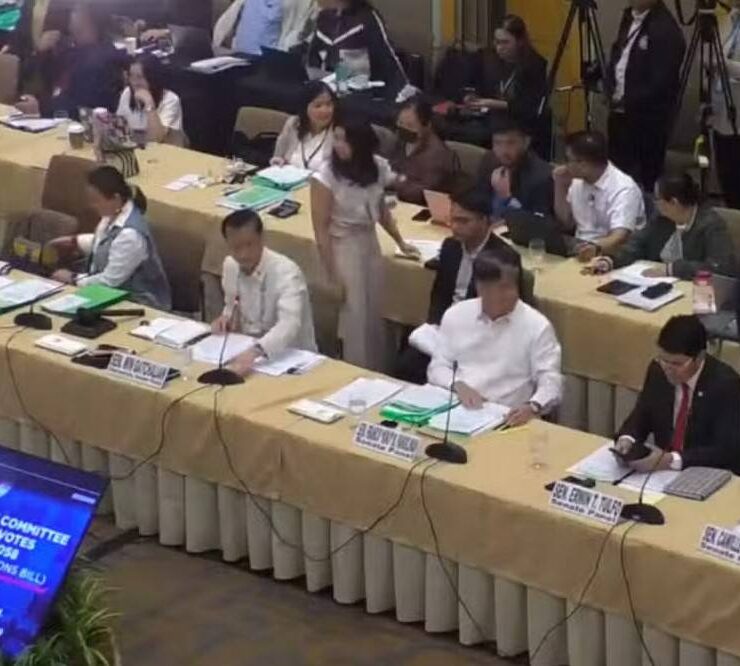When diplomatic protests vs China aggression fail

Despite the filing of more than 590 diplomatic protests in the last nine years, such recourse taken by Manila has apparently failed to curb Beijing’s aggressive behavior in the South China Sea (SCS), especially in areas where the Philippines has exclusive sovereign rights.
“[China] does it simply because it can,” said Elaine Tolentino, an analyst and former chairp of the Department of International Studies at the De La Salle University (DLSU), summing up Beijing’s conduct.
Given its sheer military might, China’s bullying strategy had advanced the Asian giant’s expansionist goals without actually going to war, Tolentino said in a recent interview with Inquirer.net.
“Diplomacy and dialogue are still necessary tools to avert a misstep,” she said, but Manila “should creatively find ways to impose actual costs on China that would question its power illusion that it is, at the moment, uncontested in its gray zone tactics.”
Based on data from the Department of Foreign Affairs, the government has filed 591 diplomatic protests against China since 2016, the year when an international arbitral tribunal invalidated Beijing’s claims to most of the South China Sea.
Acting ‘based on risks’
Geopolitical analyst Don McLain Gill, an international relations instructor also at DLSU, added: “When we talk about having a diplomatic solution (to the SCS dispute) this does not mean that we will be letting go of our capacity to defend ourselves based on international law, based on our interest as a sovereign state.”
“We have to understand that China responds based on risks, based on threat, and if we do not pose the right amount of risk or threat […] then it is likely to continue what it is doing through its salami slicing strategy,” he told Inquirer.net. “We’ve seen this.”
In a 2017 book he wrote on the Philippine-China maritime dispute, former Supreme Court Senior Associate Justice Antonio Carpio noted that before World War II, China’s southernmost defense perimeter stretched only up to Hainan Island, with not a single soldier stationed on any island in the South China Sea.
By the late 1980s, however, China had seized Fiery Cross or Kagitingan Reef and Subi or Zamora Reef. When it also took hold of Mischief or Panganiban reefs in 1995, it explained the action to the international community by claiming that the stilt structures erected would only serve as shelters for its fishermen.

‘Creeping invasion’
According to Carpio’s book titled “The South China Sea Dispute: Philippine Sovereign Rights and Jurisdiction in the West Philippine Sea,” China has since reclaimed seven reefs in the Spratlys:
• Johnson South or Mabini Reef, a high-tide elevation located 184.7 nautical miles, from Palawan and 570.8 nautical miles from China’s baseline point 39, an area called Dongzhou. It is within the exclusive economic zone (EEZ) of the Philippines.
• Hughes or McKennan Reef, a high-tide elevation located 181.3 nautical miles from Palawan and 566.8 nautical miles from China’s baseline point 39 and also within the Philippines’ EEZ.
• Cuarteron or Calderon Reef, a high-tide elevation outside the Philippine EEZ but within its extended continental shelf (ECS). It is located 245 nautical miles from Palawan and 585.3 nautical miles from China’s baseline point 39.
• Fiery Cross or Kagitingan Reef, a rock visible at 0.6 meter above water during high tide that is outside the Philippines’ EEZ but within its ECS. It is located 254.2 nautical miles from Palawan and 547.7 nautical miles from China’s baseline point 39.
• Gaven or Burgos Reef, a high-tide elevation outside the EEZ of the Philippines but within its ECS; located 203 nautical miles from Palawan and 544.1 nautical miles from China’s baseline point 39.
• Mischief or Panganiban Reef, a low-tide elevation located 125.4 nautical miles from Palawan and 598.1 nautical miles from China’s baseline point 39, within the Philippine EEZ.
• Subi or Zamora Reef, a low-tide elevation within the territorial sea of Thitu or Pagasa Island (which is occupied by the Philippines). It is located 231.9 nautical miles from Palawan and 502.2 nautical miles from China’s baseline point 39.
The number of Chinese outposts in the Spratlys as noted in Carpio’s 2017 book still stands at seven, according to data from the Asia Maritime Transparency Initiative.
Based on data from the Center for Strategic and International Studies and Philippine Navy, China has also reclaimed an area totaling 3,000 hectares inside and outside of the EEZ of the Philippines as of 2024, mainly through dredging and island-building activities.
Fiery Cross or Kagitingan Reef is now a 270-hectare island with a military airbase and three-kilometer military grade runway and a seaport, while Subi or Zamora Reef now has a 395-hectare artificial island. China also created a 394-ha artificial island on Mischief or Panganiban Reef. It has an air-and-naval base with a 3-kilometer military-grade runway.
The Philippine government called this a “creeping invasion,” challenging China’s insistence that much—or 85.7 percent—of the South China Sea lies within its so-called 10-dash line (formerly nine), which the arbitral ruling had already declared baseless and illegal.
As noted by Gill, the silence of the government throughout most of the six-year presidency of Rodrigo Duterte “emboldened China to do more against our interests in the West Philippine Sea.”
It was on July 12, 2016, the first few days of Duterte in Malacañang, when the Philippines won in the arbitration case it filed against China. Yet, it was only in 2021 and 2022 when the government started filing multiple diplomatic protests in a year.
“What we are seeing now is the unraveling, untangling of those previous mistakes, and it would take time, consistency, and continuity from our part [to correct those mistakes],” Gill said.
The only way to make China go back to the negotiating table, he said, is to make it fully realize the consequence or risks arising from its actions.
“But this does not mean that we are warmongers [as] we only have to recognize that we have to do a little bit more to ensure that equitable diplomacy is prioritized.”
“China often likes to throw its weight around. And given that we are the less-powerful state, China just wants to exploit that vulnerability,” Gill said.
“We have to continue what we are doing, not just in terms of maintaining a rules-based approach but enhancing our physical deterrence, our sea denial capabilities with our partners and our treaty ally, (and) also bolstering our national efforts in line with the archipelagic defense concept,” he said.
(A longer version of this report appears on Inquirer.net.)





















